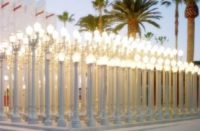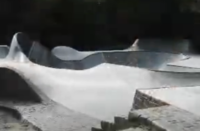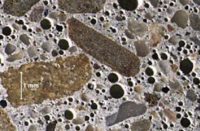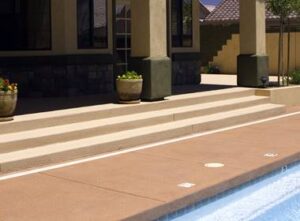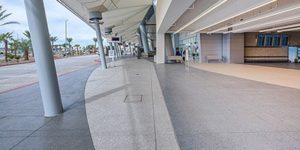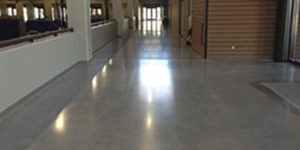Terrazzo is one of the most beautiful and long-lasting floor technologies in the world, as is evidenced by European examples several centuries old. It is prized in this country for its color and ease of maintenance as well as its durability. Terrazzo is often found where there is high traffic (airports, malls, retail) or frequent cleaning required (hospitals, restaurants).
Now, a new material, PT-300 Polyacrylate Terrazzo from Floric Polytech Inc., overcomes the design and performance limitations of existing matrix materials and offers concrete craftspeople a new business opportunity. Floric Polytech chemists worked with contractors to develop a product that would meet their requirements for handling, rapid installation and finished appearance.
 Color is its strength
Color is its strength
The most notable feature of terrazzo is its color. Colorful aggregates, especially glass and mirror, are mixed in a matrix colored to compliment or contrast. But until now contractors had to make some color trade-offs. Epoxy materials could be brightly colored and they were pliable enough to hold a high concentration of glass aggregate, but they were not stable under sun exposure. They could never be used outside. Even sodium or halogen indoor light systems could cause epoxies to fade. Cement materials were too stiff to hold glass aggregate, while polyacrylate was too soft. Glass was prone to pop out during the grinding process. The industry recommended that aggregate used with these materials contain no more than 10 percent glass. In addition, the color palette for the matrix itself was limited to subdued tones.
PT-300 was formulated to eliminate both of these problems. Its nonsilica formulation ends the problem of glass popping out. Daniel Chavarria, owner of DC Flooring in Temecula, Calif., and Ohana Flooring in Honolulu, Hawaii, was an early tester and advisor on the development of PT-300. “Glass is not porous like marble, so there is nothing to grab on to the matrix,” he says. “With PT-300 I can use 100 percent glass. The colors I achieve with this material are unbelievable. I can use mother-of-pearl or mirror to make the colors pop.” Chavarria consulted with Floric during product development and now works with them in training contractors how to use it.
 The formulation also holds vibrant colors and is completely resistant to UV fading. “We use high-end infrared reflective pigments that reflect light, so the colors are stable under sunlight,” says Brent Strait, president of Floric Polytech and the lead chemist developing PT-300. “They also reflect heat, so you can have a black surface outside that won’t get hot. Iron oxide and synthetic pigments are not UV stable.” Pigment packs are supplied in 45 stock colors, and the company is developing a library of custom colors as well.
The formulation also holds vibrant colors and is completely resistant to UV fading. “We use high-end infrared reflective pigments that reflect light, so the colors are stable under sunlight,” says Brent Strait, president of Floric Polytech and the lead chemist developing PT-300. “They also reflect heat, so you can have a black surface outside that won’t get hot. Iron oxide and synthetic pigments are not UV stable.” Pigment packs are supplied in 45 stock colors, and the company is developing a library of custom colors as well.
Chavarria describes a project where this color capability was crucial. A compass rose — a popular design for terrazzo as well as decorative concrete — was specified for a project in Las Vegas. The compass was set in a doorway, so half would be inside, half outside. It was originally specified as cement terrazzo to avoid the problem of epoxy fading, but the owners wanted brighter colors. Only Floric PT-300 could deliver everything the customer wanted.
 |
 |
Fast and green
One reason epoxy is more popular than cement is that it can be installed relatively easily and cures quickly for grinding and polishing. Cement can require up to a week to cure before polishing, and cured cement often has pinholes and craters that must be filled. Old-style polyacrylates are also slow to cure. PT-300 is designed to cure and be ready to grind in eight hours. Quick curing is essential in places that require a rapid return to service. Strait gives the example of a mall project where retail space generated $180,000 per day, a significant loss every day the mall was closed. “If you can shave a day or more off their closed schedule, they are willing to pay,” he says.
PT-300 can be installed vertically with the addition of a thickening additive on-site. “Some people are going up 30 feet high because terrazzo is so beautiful and durable,” Strait says. And unlike other polyacrylate products, PT-300 can be washed to expose the aggregate for a rustic terrazzo finish.
One reason epoxy is not popular is the solvent used as a carrier and for cleanup. “When you work with epoxy you have to throw your clothes away,” Chavarria says. What’s more, because of the solvent content, epoxy cannot be used at all in certain settings like hospitals or commercial buildings with common ventilation systems. In contrast, the acrylic polymer used for polyacrylates is water-based, so there are no harsh chemicals and cleanup is easy. PT-300 is also completely free of volatile organic compounds.
It is even possible to buy recycled glass and stone aggregates that are LEED-compliant, making terrazzo floors made with PT-300 even more attractive for green building.
Poised to grow
Terrazzo installers have long been a relatively exclusive group, but Floric Polytech is making it easier for high-end decorative concrete contractors to add this technique to their repertoire. “If you can grind and polish concrete, you are halfway to doing terrazzo,” Chavarria claims.
Strait believes that terrazzo is where stamped concrete was in the 1970s — poised to grow. To help that happen, Floric is offering training to help contractors and artisans qualify to purchase and install their products. The hands-on training also silences skeptics. “We make a mix with 100 percent glass aggregate,” Strait explains. “We pour in the morning and polish later that same day. You can hear a hush fall over the crowd about 2 o’clock in the afternoon.”
